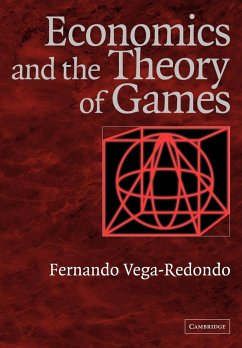This textbook is designed for students in economics seeking a self-contained approach to game theory.
This textbook offers a systematic, self-contained account of the main contributions of modern game theory and its applications to economics. Starting with a detailed description of how to model strategic situations, the discussion proceeds by studying basic solution concepts, their main refinements, games played under incomplete information, and repeated games. For each of these theoretical developments, there is a companion set of applications that cover the most representative instances of game-theoretic analysis in economics, e.g. oligopolistic competition, public goods, coordination failures, bargaining, insurance markets, implementation theory, signaling and auctions. The theory and applications covered in the first part of the book fall under the so-called 'classical' approach to game theory, which is founded on the paradigm of players' unlimited rationality. The second part shifts towards topics that no longer abide by that paradigm. This leads to the study of topics such as the interplay between evolution and rationality.
Table of content:
Part I. Theoretical Framework: 1. Introduction and examples; 2. The representation of a game in extensive form; 3. The representation of a game in strategic form; 4. The mixed extension of a game; 5. Mixed and behavioral strategies; 6. Representation in coalition form; Summary; Exercises; Part II. Strategic-Form Analysis: Theory: 7. Dominance and iterative dominance; 8. Nash equilibrium; 9. Zero-sum bilateral games; 10. Nash equilibrium: formal existence results; 11. Strong and coalition-proof equilibrium; 12. Correlated equilibrium; 13. Rationalizability; Summary; Exercises; Part III. Strategic-Form Analysis: Applications: 14. Oligopoly (I): static models; 15. Mechanism design (I): efficient allocation of public goods; 16. Mechanism design (II): Nash implementation; 17. Markets (I): macroeconomic coordination failures; Summary; Exercises; Part IV. Refinements of Nash Equilibrium: Theory: 18. Introduction; 19. Refinements excluding 'incredible threats': examples; 20. Subgame-perfect equilibrium; 21. Weak-perfect Bayesian equilibrium; 22. Refinements excluding 'untenable beliefs': examples; 23. Sequential equilibrium; 24. Perfect and proper equilibria; 25. Strategic-form refinements; Summary; Exercises; Part V. Refinements of Nash Equilibrium: Applications: 26. Oligopoly (II): sequential moves; 27. Markets (II): decentralized price formation; 28. Oligopoly (III): differentiated products; 29. Mechanism design (III): efficient allocation of an indivisible object; Summary, Exercises; Part VI. Incomplete Information: Theory: 30. Introduction and examples; 31. Bayesian games; 32. Bayes-Nash equilibrium; 33. Signalling games; 34. Mixed strategies revisited: a purification approach; 35. Forward induction; Summary; Exercises; Part VII. Incomplete Information: Applications: 36. Markets (III): signalling in the labor market; 37. Markets (IV): insurance markets and adverse selection; 38. Mechanism design (IV): one-sided auctions; 39. Mechanism design (V): buyer-seller trade; Summary; Exercises; Part VIII. Repeated Interaction: Theory: 40. Introduction and examples; 41. Repeated games: basic theoretical framework; 42. Folk theorems: Nash equilibrium; 43. Reputation and 'irrationality': informal discussion; 44. Folk theorems: subgame=perfect equilibrium; 45. Reputation and 'irrationality': formal analysis; Summary; Exercises; Part IX. Repeated Interaction: Applications: 46. Oligopoly (IV): intertemporal collusion in a Cournot scenario; 47. Oligopoly (V): intertemporal collusion in a Bertrand scenario; 48. Markets (V): efficiency, wages and unemployment; Summary; Exercises; Part X. Evolutionary Foundations of Equilibrium: 49. Introduction; 50. Static analysis; 51. Basic dynamic analysis; 52. Evolution in social environments; 53. The evolution of cooperation: an example; Summary; Exercises; Part XI. Learning to Play: 54. Introduction; 55. Reinforcement learning; 56. Static perceptions and Nash equilibrium; 57. Memory, expectations and foresight; Summary; Exercises; Part XII. Social Learning and Equilibrium Selection: 58. Introduction; 59. Evolutionary games: theoretical framework; 60. Evolutionary games: alternative scenarios; 61. Stochastic stability and equilibrium selection; 62. Experimental evidence; 63. Perturbed Markov processes: basic concepts and techniques; 64. Reinforcement learning with flexible aspirations; Summary; Exercises.
Hinweis: Dieser Artikel kann nur an eine deutsche Lieferadresse ausgeliefert werden.
This textbook offers a systematic, self-contained account of the main contributions of modern game theory and its applications to economics. Starting with a detailed description of how to model strategic situations, the discussion proceeds by studying basic solution concepts, their main refinements, games played under incomplete information, and repeated games. For each of these theoretical developments, there is a companion set of applications that cover the most representative instances of game-theoretic analysis in economics, e.g. oligopolistic competition, public goods, coordination failures, bargaining, insurance markets, implementation theory, signaling and auctions. The theory and applications covered in the first part of the book fall under the so-called 'classical' approach to game theory, which is founded on the paradigm of players' unlimited rationality. The second part shifts towards topics that no longer abide by that paradigm. This leads to the study of topics such as the interplay between evolution and rationality.
Table of content:
Part I. Theoretical Framework: 1. Introduction and examples; 2. The representation of a game in extensive form; 3. The representation of a game in strategic form; 4. The mixed extension of a game; 5. Mixed and behavioral strategies; 6. Representation in coalition form; Summary; Exercises; Part II. Strategic-Form Analysis: Theory: 7. Dominance and iterative dominance; 8. Nash equilibrium; 9. Zero-sum bilateral games; 10. Nash equilibrium: formal existence results; 11. Strong and coalition-proof equilibrium; 12. Correlated equilibrium; 13. Rationalizability; Summary; Exercises; Part III. Strategic-Form Analysis: Applications: 14. Oligopoly (I): static models; 15. Mechanism design (I): efficient allocation of public goods; 16. Mechanism design (II): Nash implementation; 17. Markets (I): macroeconomic coordination failures; Summary; Exercises; Part IV. Refinements of Nash Equilibrium: Theory: 18. Introduction; 19. Refinements excluding 'incredible threats': examples; 20. Subgame-perfect equilibrium; 21. Weak-perfect Bayesian equilibrium; 22. Refinements excluding 'untenable beliefs': examples; 23. Sequential equilibrium; 24. Perfect and proper equilibria; 25. Strategic-form refinements; Summary; Exercises; Part V. Refinements of Nash Equilibrium: Applications: 26. Oligopoly (II): sequential moves; 27. Markets (II): decentralized price formation; 28. Oligopoly (III): differentiated products; 29. Mechanism design (III): efficient allocation of an indivisible object; Summary, Exercises; Part VI. Incomplete Information: Theory: 30. Introduction and examples; 31. Bayesian games; 32. Bayes-Nash equilibrium; 33. Signalling games; 34. Mixed strategies revisited: a purification approach; 35. Forward induction; Summary; Exercises; Part VII. Incomplete Information: Applications: 36. Markets (III): signalling in the labor market; 37. Markets (IV): insurance markets and adverse selection; 38. Mechanism design (IV): one-sided auctions; 39. Mechanism design (V): buyer-seller trade; Summary; Exercises; Part VIII. Repeated Interaction: Theory: 40. Introduction and examples; 41. Repeated games: basic theoretical framework; 42. Folk theorems: Nash equilibrium; 43. Reputation and 'irrationality': informal discussion; 44. Folk theorems: subgame=perfect equilibrium; 45. Reputation and 'irrationality': formal analysis; Summary; Exercises; Part IX. Repeated Interaction: Applications: 46. Oligopoly (IV): intertemporal collusion in a Cournot scenario; 47. Oligopoly (V): intertemporal collusion in a Bertrand scenario; 48. Markets (V): efficiency, wages and unemployment; Summary; Exercises; Part X. Evolutionary Foundations of Equilibrium: 49. Introduction; 50. Static analysis; 51. Basic dynamic analysis; 52. Evolution in social environments; 53. The evolution of cooperation: an example; Summary; Exercises; Part XI. Learning to Play: 54. Introduction; 55. Reinforcement learning; 56. Static perceptions and Nash equilibrium; 57. Memory, expectations and foresight; Summary; Exercises; Part XII. Social Learning and Equilibrium Selection: 58. Introduction; 59. Evolutionary games: theoretical framework; 60. Evolutionary games: alternative scenarios; 61. Stochastic stability and equilibrium selection; 62. Experimental evidence; 63. Perturbed Markov processes: basic concepts and techniques; 64. Reinforcement learning with flexible aspirations; Summary; Exercises.
Hinweis: Dieser Artikel kann nur an eine deutsche Lieferadresse ausgeliefert werden.








